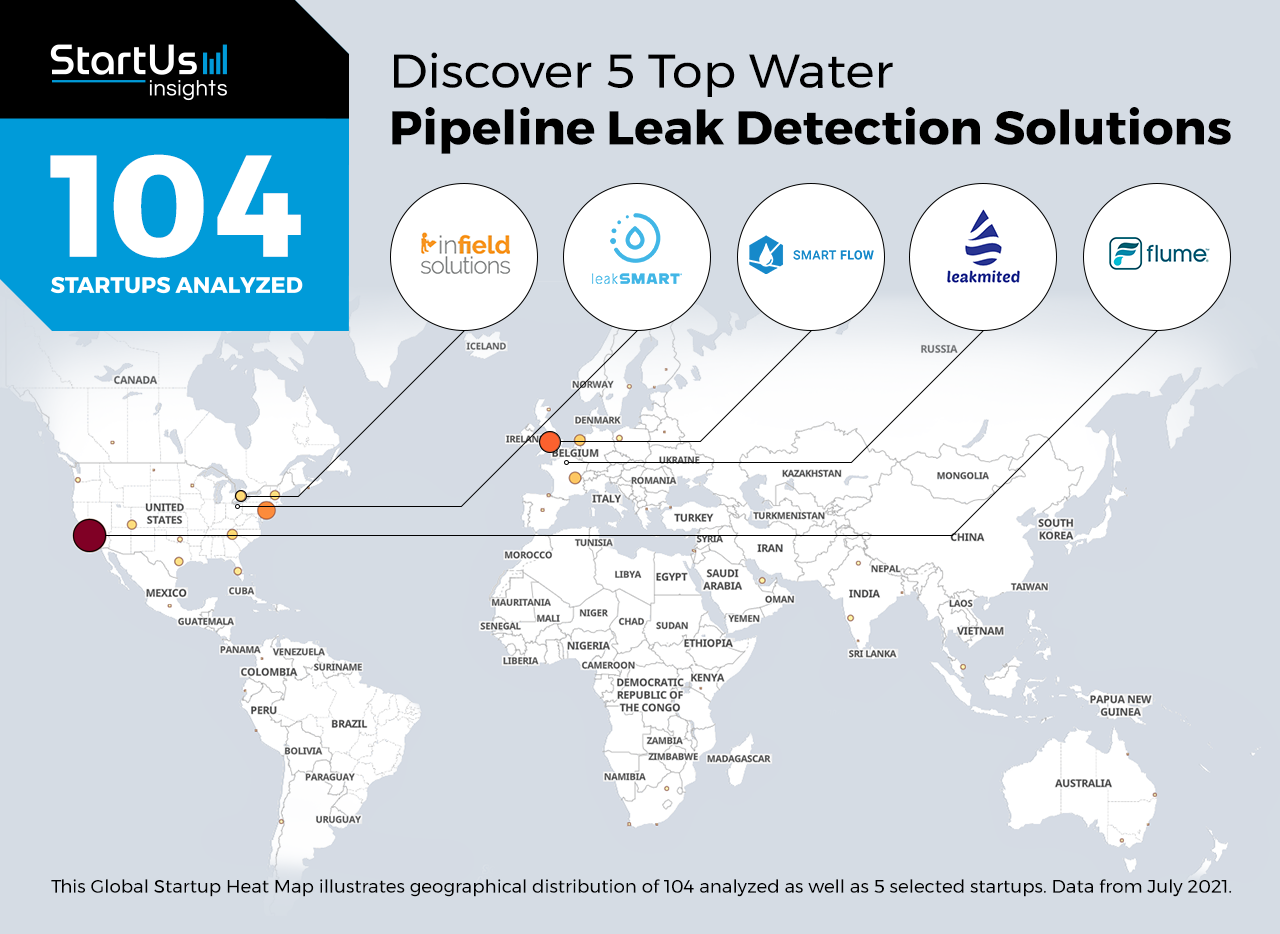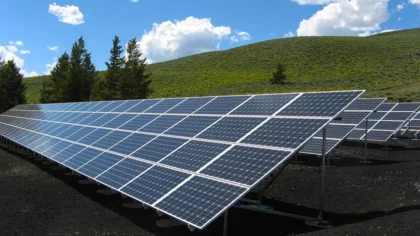Staying ahead of the technology curve means strengthening your competitive advantage. That is why we give you data-driven innovation insights into water management. This time, you get to discover 5 hand-picked water pipeline leak detection solutions.
Global Startup Heat Map highlights 5 Top Water Pipeline Leak Detection Solutions out of 104
The insights of this data-driven analysis are derived from the Big Data & Artificial Intelligence-powered StartUs Insights Discovery Platform, covering 2.093.000+ startups & scaleups globally. The platform gives you an exhaustive overview of emerging technologies & relevant startups within a specific field in just a few clicks.
The Global Startup Heat Map below reveals the distribution of the 104 exemplary startups & scaleups we analyzed for this research. Further, it highlights 5 startups offering water pipeline leak detection solutions that we hand-picked based on criteria such as founding year, location, funding raised, and more. You get to explore the solutions of these 5 startups & scaleups in this report. For insights on the other 99 water pipeline leak detection solutions, get in touch.
Smart Flow works on a Micro Leak Detection System
Water leaks presently are treated based on the visibility of the leak. However, ignoring smaller leaks leads to a massive amount of water loss from industrial or residential facilities every year. Besides, small cracks expand and can damage entire pipelines. To avoid this, startups are developing micro leak detection systems to manage water leaks as and when they occur, as well as notify respective parties.
British startup Smart Flow provides micro leaks monitoring and detection systems. The startup uses an ultrasonic flow sensor that monitors water flow in real-time at residential and commercial buildings. The system is also integrable with existing systems and uses algorithms to detect a leak or excessive water usage. The solution then sends notifications to relevant stakeholders, allowing them to remotely shut off from the water supply.
Flume offers Magnetic Field Sensor Technology
Traditionally, monitoring a water meter requires shutting the entire water system and then monitoring the change in the water meter. This method is inefficient as it disrupts the water usage of the facility and is also time-consuming. Therefore, startups are developing solutions to continuously observe changes in the water meter.
US-based startup Flume offers a magnetic field sensor technology for water leak detection. The startup’s Smart Home Water Monitor solution creates a magnetic field around the water meter. It then detects water usage and leaks by applying machine learning algorithms. The system consists of a sensor attached to the water meter, a bridge device connected to the WiFi, as well as an application that displays leak notifications and real-time water data.
inField Solutions provides IoT-based Water Leak Detection
With the advent of large infrastructure projects, detecting leaks in the pipes becomes a complex and time-consuming activity. Installation of sensors eases the task as manual inspection-related errors get eliminated. Startups are developing internet of things (IoT)-based leak detection systems to notify stakeholders and minimize losses due to water leaks.
Canadian startup inField Solutions provides a smart water leak detection platform. The startup’s platform renders continuous monitoring of the plumbing, notifying the appropriate stakeholders, and dispatching plumbers. The system uses IoT devices that are scalable and expandable to existing buildings or infrastructure. This further enables a reduction in waste, damage, and insurance costs.
LeakSmart builds a Leak Detection Solution with Valve Control
The detection of water leaks often takes place after the leakage happens. However, detecting potential leaks based on the change in water flow patterns helps mitigate the risk before they arise, enabling the initiation of auto shut-off. Therefore, startups and emerging companies are developing leak detection solutions based on water flow monitoring to identify leaks in advance.
LeakSmart, a US-based startup, provides Protect to automatically shut off the water when leaks are detected in pipelines. The startup’s solution consists of water sensors, a valve controller, a central hub, and a mobile application. The solution detects burst pipes, appliance leaks, or potential in-wall leaks based on the increase in the water flow against a set daily usage limit. It initiates automatic shut-off when a leak is detected after sending an alert. Besides, the system offers an automatic periodic cleaning to prevent mineral build-up, which may later lead to leakage.
LEAKMITED enables Satellite-based Leak Detection
The currently used method of leak detection in underground piping systems uses noise amplification to detect leaks. However, this method is inefficient for systems built under concrete structures as well as widespread and extensive pipeline layouts. At the same time, satellite images of the pipe layout help in determining the position of the leak. Therefore, startups are developing satellite image-based solutions for leak detection.
French startup LEAKMITED provides leak detection solutions based on satellite images and deep learning. The solution locates underground water leakage using electromagnetic satellite-based images that sense the ground. The solution then uses an AI assistant to locate the leaks faster. The deep learning tool processes satellite imagery and historical data to detect the patterns induced by the presence of water.
Discover more Water Management Startups
Startups such as the examples highlighted in this report focus on water leak detection solutions using valves, satellite data, magnetic fields as well as IoT. While all of these technologies play a major role in reducing water waste, they only represent the tip of the iceberg. To explore more water management technologies, simply get in touch to let us look into your areas of interest. For a more general overview, you can download one of our free Industry Innovation Reports to save your time and improve strategic decision-making.










